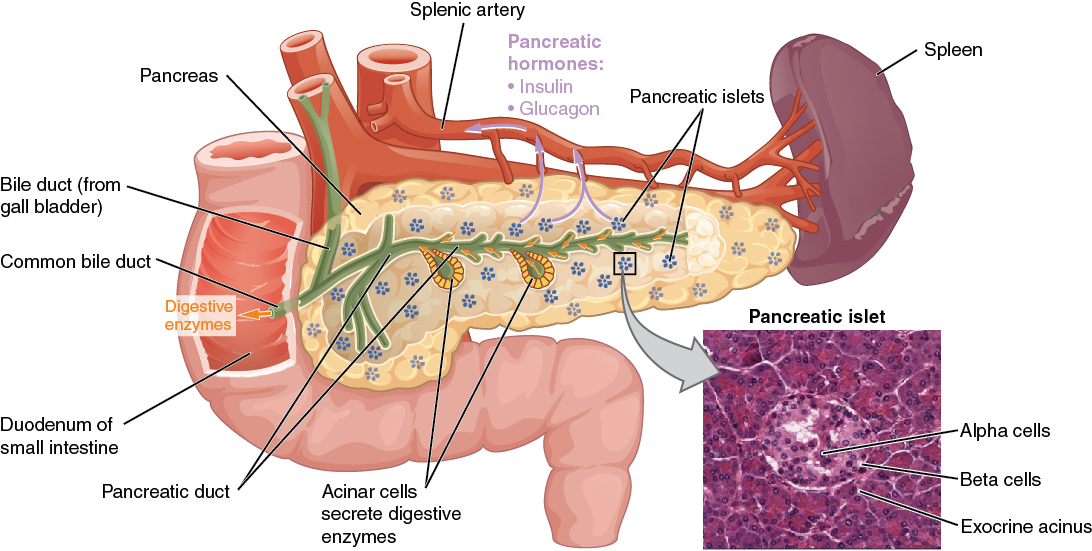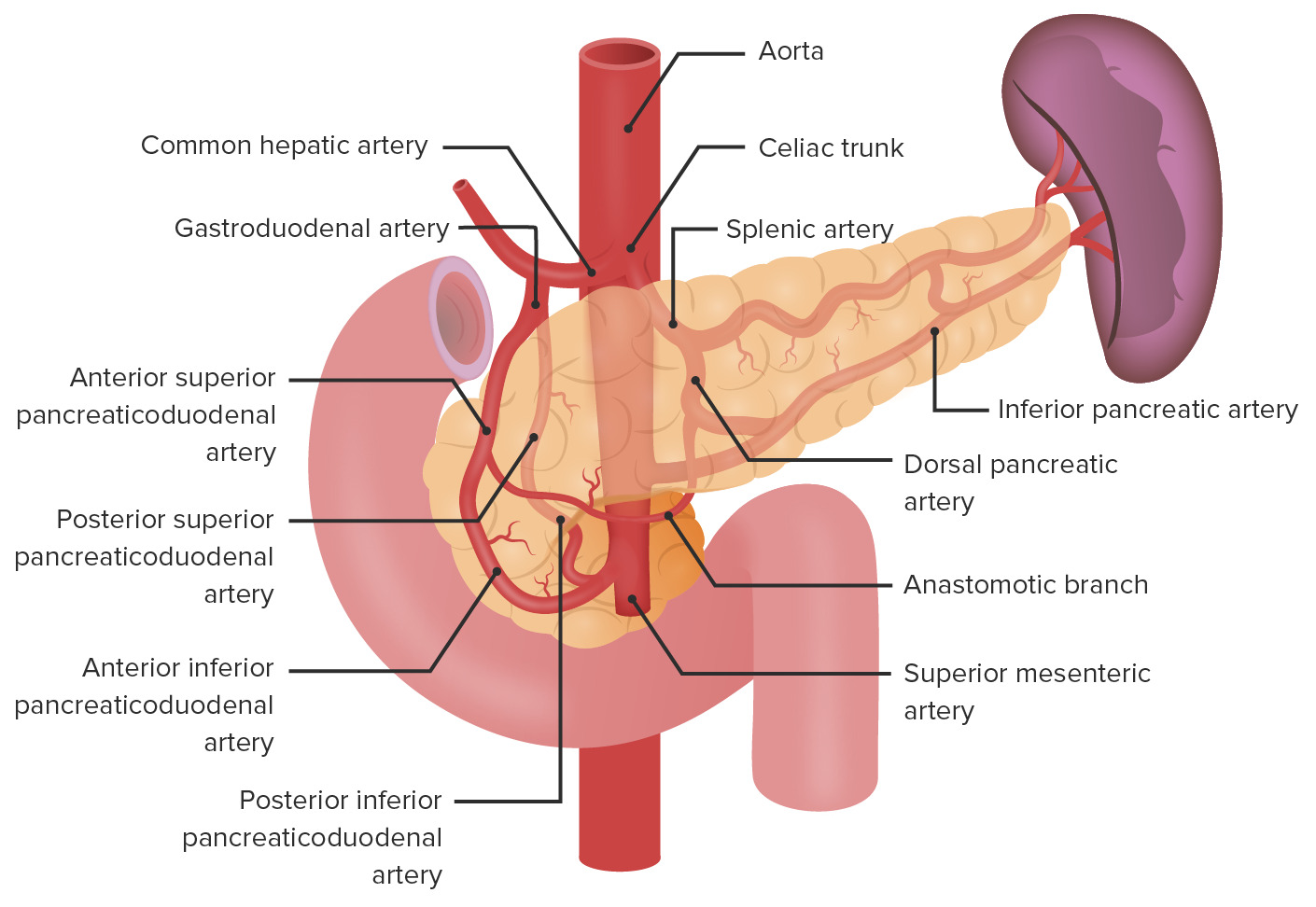Playlist
Show Playlist
Hide Playlist
Exocrine Pancreas – Lower Gastrointestinal Secretion
-
Slides 03 LowerGastrointestinalSecretion GastrointestinalSystem.pdf
-
Download Lecture Overview
00:01
So these enzymes from the pancreas
involve amylase for carbohydrates.
00:06
Remember we also had a salivary amylase
that is secreted in the salivary gland.
00:11
In terms of fats,
we have lipase.
00:14
We have phospholipase A2 and
we have cholesterol esterase.
00:20
Also recall that there
was a lingual lipase
that was also secreted
in the salivary glands.
00:28
We also have enzymes for various
proteins such as chymotrypsin,
trypsinogen, pro-elastase
and carboxypeptidase.
00:36
Now these protein ones are in
addition to the pepsinogen and pepsin
that is secreted in the stomach.
00:45
Finally, we have nucleotides and these will
help break down RNA and DNA molecules.
00:51
So besides enzymes, there are other
things that are secreted by the pancreas.
00:56
These are ions and water
and the primary ion we need to
contain ourselves with is bicarb.
01:03
And why do we need to do be so –
important or have
eye out for bicarb
is because remember in the stomach,
we secreted all those hydrogen ions.
01:12
We need some way to buffer those hydrogen
ions once we get to the small intestines
where those hydrogen ions of that
low acidity will end up
eating away portions of
the small intestines.
01:27
So just like our other secretions,
we can set up secretions based upon the
flow rate of the secreted substance
and the concentration
of that ion.
01:39
So let’s start with sodium.
01:41
Sodium, there is no real change in terms
of its flow rate and concentration.
01:45
And it is very similar
to what it is in plasma.
01:50
Potassium also does not
change very much across
flow rates of various
pancreatic secretions.
01:58
Chloride does change though.
02:00
As you increase the flow rate
of pancreatic secretions,
you have a decrease in the
chloride concentration.
02:09
And that is lower than
what occurs in the plasma,
meaning that you are
reabsorbing it.
02:18
Bicarb is the opposite of chloride in
which as you increase the flow rate,
you increase the amount of bicarb secreted.
02:25
How do I know it’s secreted is because
it’s above the level of the plasma.
02:31
So that’s how we control and
regulate some of the ions.
02:36
How do we deal with enzymes?
Now enzymes can be situated in this kind
of format where we have acinar cells.
02:45
We’re going to have a couple
of different membranes.
02:48
We have the interstitial space,
the basolateral membrane,
the acinar cells themselves, the
apical membrane and then the lumen.
02:58
We are going to be releasing enzymes
from the endoplasmic reticulum,
Golgi apparatus and those
vesicles will then bind and fuse
to the apical membrane and then submit
their enzymes out into the lumen.
03:14
Ions encompass a little
bit more complex process.
03:17
Here, carbon dioxide
goes into the cells.
03:21
Carbonic anhydrase changes the
carbon dioxide in the water
into bicarb and hydrogen ions.
03:32
Then,
hydrogen ions are
exchanged for sodium.
03:38
Bicarb is exchanged
for chloride.
03:39
This is how it secretes bicarbonate
across the apical membrane.
03:47
Chloride completes the process.
03:49
And finally, sodium is
excreted out of the cell.
03:55
Then, in regards to this bicarb exchange,
both sodium and water are pulled into the
lumen of these pancreatic secretions.
04:09
Now, what it controls and regulates
is pancreatic secretions.
04:13
About 25% of the amount secretions
are done via the cephalic phase.
04:20
And remember from the cephalic phase,
this involves primarily the vagus nerve
or cranial nerve number X,
releasing acetylcholine.
04:28
About 10% of secretions are
controlled during the gastric phase.
04:33
And these are through the
vago-vagal reflexes.
04:35
Finally, the most important
is the intestinal phase.
04:40
And these will involve two
different substances.
04:43
One is called secretin and the
other is cholecystokinin.
04:47
These will be the primary regulators
during the intestinal phase
and of pancreatic
secretions in general.
04:57
So acid from the stomach releases secretin
and secretin is released
from the duodenal cells.
05:04
And this is in response to
both fats and amino acids
will cause the release
of cholecystokinin.
05:11
So our two different substances
are secretin and cholecystokinin.
05:17
These then will be absorbed
in the blood stream,
delivered through the pancreas
and also the vagus stimulates
the release of various enzymes
into the acini lumen as well.
05:34
Both of these together
cause large amounts of
secretions of pancreatic
fluid especially bicarb.
05:41
Now, how do each of these
substances cause these secretions?
Let’s start with acetylcholine.
05:50
So acetylcholine, cholecystokinin
are two primary regulators
to increase the amount
of cytosolic calcium.
05:57
This cytosolic calcium
causes phosphorylation
of various structure
and regulatory protein,
which then causes docking and
fusing of these granules
or vessels that have
enzymes in them.
06:11
Now besides acetylcholine
and cholecystokinin,
secretin is a primary regulator
of these secretions.
06:21
These works via cyclic AMP mechanism to
also phosphorylate structural proteins
and help the process of these
granules to dock and fuse
into the apical membrane to spill their
contents in the intestinal lumen.
06:40
The intestines also do some secretions,
not as much as the pancreas itself,
but they also will secrete things
like mucus from goblet cells.
06:51
Endothelial cells will secrete some
serous solutions as well as Paneth cells.
06:58
Their primary function though is to
increase the amount of fluid and mucus
in the intestines for
protective reasons,
not to undergo digestion,
rather to protect the small intestine
and large intestine walls.
07:14
To begin to talk about biliary secretions,
let’s start off with the gallbladder.
07:17
The gallbladder is the primary
storehouse for biliary secretions.
07:23
In this phase, what happens
is from the hepatic ducts,
bile is drained from the liver and will
be stored then in the gallbladder.
07:32
The bile duct itself is where the bile
will be released into the small intestine.
07:40
Why do you produce billiary secretions?
In fact, they don’t do very
much in terms of digestion.
07:47
But they do emulsify fats,
very similar to the way detergents
emulsify fats in your dishwater.
07:55
So they don’t breakdown the fats, they
glob them together or emulsify them.
About the Lecture
The lecture Exocrine Pancreas – Lower Gastrointestinal Secretion by Thad Wilson, PhD is from the course Gastrointestinal Physiology.
Included Quiz Questions
Which of the following ions is secreted from the pancreas to aid the neutralization of acid in the small intestines?
- Bicarbonate
- Chloride
- Sodium
- Potassium
- Magnesium
Which of the following substances upregulates the secretion of enzymes, from the pancreas, in response to fats and amino acids entering the duodenum?
- Cholecystokinin
- Amylase
- Secretin
- Nuclease
- Trypsinogen
Which of the following substance utilizes cAMP, as a second messenger, to increase secretions from the exocrine pancreas?
- Secretin
- Cholecystokinin
- Acetylcholine
- Gastrin-releasing peptide
- Amylase
What is the primary function of hepatic secretions stored in the gall bladder?
- Fat emulsification
- Fat digestion
- Peptide digestion
- Carbohydrate digestion
- Acid neutralization
Customer reviews
5,0 of 5 stars
| 5 Stars |
|
2 |
| 4 Stars |
|
0 |
| 3 Stars |
|
0 |
| 2 Stars |
|
0 |
| 1 Star |
|
0 |
This course in general is very well explained, but this conference has really been very clear for my understanding of this subject. Thanks Dr. Wilson!
I know that you spent a lots of time to learn physiology. You provide us in a very short time. I am very excited to follow your videos and I relay appreciate your presentations. GOD BLESS YOU.





